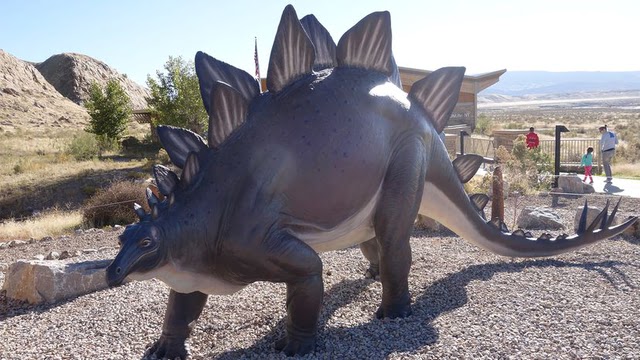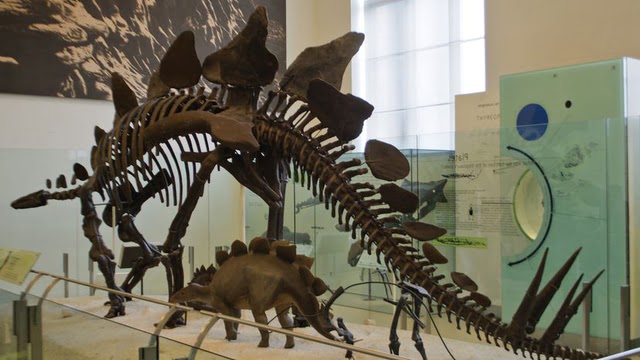Quck answer
Stegosaurus was a herbivorous dinosaur that lived during the Late Jurassic period. It had a massive body, up to 9 meters long and weighing around 2 tons, but its brain was very small, about the size of a walnut. Despite its large size, Stegosaurus was not a fast runner and probably relied on its bony plates and spikes for defense against predators. It had a unique posture, with its spine and tail held parallel to the ground, and its hind legs longer than its front legs. Stegosaurus is one of the most recognizable dinosaurs, and its distinctive appearance has made it a popular subject in popular culture.
Extinct Animals

A replica of Stegosaurus is on display at Dinosaur National Monument, Utah. Wikimedia Commons (CC BY-SA 4.0)
Some words can become fossils in their own right. Triceratops means “three-horned face” and Velociraptor means “speedy plunderer.” Both names fit the dinosaurs they belong to; we know Triceratops had a trio of horns on its skull while Velociraptor was a lightly-built carnivore.
The name of Stegosaurus, a Jurassic plant-eater, is not so straightforward. Rooted in Greek, it means “roofed lizard,” which made more sense when the animal was first discovered 140 years ago.
Timing is Everything
Hollywood, take note. Films like “Fantasia” and “Planet of Dinosaurs” show Stegosaurus fighting against the popular bone-crusher, Tyrannosaurus rex. But here’s the catch: these two dinosaurs never lived at the same time.
Tyrannosaurus lived from 68 to 65.5 million years ago, while Stegosaurus existed much earlier. The oldest specimens are around 155 million years old, while the youngest were fossilized 150 million years ago.
So T. rex actually lived closer to the time of humans than to Stegosaurus.
Stegosaurus roamed Earth during the Jurassic Period, which lasted from 199.6 million to 145.5 million years ago. Although it could be found in Portugal, Stegosaurus is mainly known from fossil sites in western North America.
Stegosaurus belonged to a group of dinosaurs called stegosaurs, which walked on four legs and had long, beak-tipped skulls.
But the most striking feature of stegosaurs was their ornaments. Spikes adorned the tails of every known species, and some, like Africa’s Kentrosaurus, also had large spikes on their shoulders and lower back.
And where the back spikes ended, a much stranger feature began. Stegosaurus and its kin are distinguished by the vertical plates above their spines.
“Show Me the Plates”
We may never know how these things functioned. Paleontologist Othniel Charles Marsh named Stegosaurus in 1877, believing the plates were sheets of armor that laid flat against the animal’s backside.
Later discoveries proved the objects stood upright, leaving the flanks of these dinosaurs exposed.
Because the plates contained blood vessels, experts once thought they helped stegosaurs regulate their body temperature. Heat would supposedly dissipate from blood as it entered the tall, fan-like structures. After this cooled blood circulated elsewhere, it would lower the overall body temperature.

A full skeleton of an adult Stegosaurus, as well as a few bones from a baby specimen, are on display at the American Museum of Natural History in New York City.
InSapphoWeTrust/Flickr (CC BY-SA 2.0)
However, this hypothesis is no longer popular. A study published in 2005 in the journal Paleobiology suggests that the blood-carrying networks in Stegosaurus plates were there to promote healthy bone growth, but did not play a role in dissipating body heat.
Perhaps Stegosaurus and its relatives were just showing off. Made of bone and covered in horny sheaths, the plates could have made these dinosaurs look larger and more intimidating.
The End of Business
Stegosaurus was a massive dinosaur that could reach up to 29.5 feet (9 meters) in length and weigh around 5 tons (4.5 metric tons). Even though it was one of the largest stegosaurs, it was overshadowed by its bigger neighbors, the sauropods, which included the 60-foot (18-meter) Camarasaurus and the 80-foot (24-meter) Diplodocus during the late Jurassic period.
Stegosaurus didn’t have to worry about the infamous T. rex, but it had to fend off other Jurassic predators like the Allosaurus, which could measure up to 28 feet (8.5 meters) and had serrated teeth and jaws that could open up to 79 degrees. Fortunately, Stegosaurus had four tail spikes to defend itself. Researchers found evidence of trauma on 10 percent of these fossils indicating that they saw action against predators.
Stegosaurus was a herbivorous dinosaur that most likely browsed on low-lying vegetation like cycads, and a computer simulation in 2016 showed that it had a bite force comparable to a sheep or cow. Interestingly, Stegosaurus had a tiny brain cavity that weighed only about 20.8 ounces (80 grams), which made up about 0.001 percent of its total body weight. Some rumors suggested that Stegosaurus had a second brain located in the backbones above its hip region, but researchers think it was just an opening that stored glycogen, a sugar that provides cells with energy.
Stegosaurus had some unique features that helped protect it from predators. Its four tail spikes were effective in defense, and it also had gular armor, which were tiny, pebble-shaped chunks of bone that covered its throat and protected it from carnivores that went for the jugular. Stegosaurus was Colorado’s official state fossil and was the inspiration for Godzilla’s dorsal plates.
FAQ
1. What is a Stegosaurus?
A Stegosaurus is a type of dinosaur that lived during the late Jurassic period, around 150 million years ago. It is known for its distinctive body shape, with bony plates along its back and a spiked tail.
2. How big was a Stegosaurus?
A Stegosaurus was about 30 feet long and weighed up to 5 tons, making it one of the largest herbivorous dinosaurs of its time.
3. Why did Stegosaurus have bony plates on its back?
It is believed that the bony plates on a Stegosaurus’s back were used for defense against predators or for regulating body temperature.
4. How many plates did a Stegosaurus have?
A Stegosaurus had between 17 and 22 bony plates along its back, arranged in two rows.
5. Why did Stegosaurus have a spiked tail?
The spiked tail of a Stegosaurus was likely used for defense against predators or for competing with other Stegosauruses during mating season.
6. How did Stegosaurus move?
Stegosaurus moved on four legs and was a slow-moving dinosaur, with a top speed estimated to be around 5 miles per hour.
7. Did Stegosaurus have a small brain?
Yes, despite its large body size, Stegosaurus had a brain that was about the size of a walnut, making it one of the dinosaurs with the smallest brains relative to its body size.
8. What did Stegosaurus eat?
Stegosaurus was an herbivore, meaning it mainly ate plants such as ferns, cycads, and conifers.
9. Where have Stegosaurus fossils been found?
Stegosaurus fossils have been found in North America, specifically in states such as Colorado, Wyoming, and Utah.
10. When did Stegosaurus go extinct?
Stegosaurus went extinct around 150 million years ago, at the end of the Jurassic period.
11. Are there any living descendants of Stegosaurus?
No, all species of Stegosaurus went extinct millions of years ago and have no living descendants.





Leave a Reply